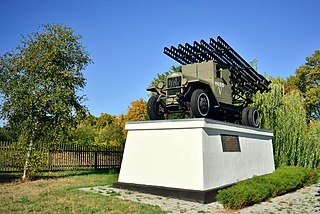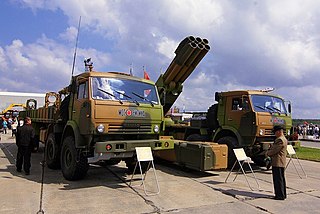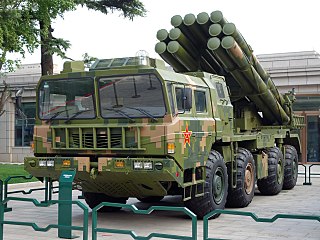
The Katyusha is a type of rocket artillery first built and fielded by the Soviet Union in World War II. Multiple rocket launchers such as these deliver explosives to a target area more intensively than conventional artillery, but with lower accuracy and requiring a longer time to reload. They are fragile compared to artillery guns, but are cheap, easy to produce, and usable on any chassis. The Katyushas of World War II, the first self-propelled artillery mass-produced by the Soviet Union, were usually mounted on ordinary trucks. This mobility gave the Katyusha, and other self-propelled artillery, another advantage: being able to deliver a large blow all at once, and then move before being located and attacked with counter-battery fire.

A multiple rocket launcher (MRL) is a type of rocket artillery system that contains multiple launchers which are fixed to a single platform, and shoots its rocket ordnance in a fashion similar to a volley gun. Rockets are self-propelled in flight and have different capabilities than conventional artillery shells, such as longer effective range, lower recoil, typically considerably higher payload than a similarly sized gun artillery platform, or even carrying multiple warheads.

The BM-27 Uragan is a self-propelled 220 mm multiple rocket launcher designed in the Soviet Union. The system began its service with the Soviet Army in the late 1970s, and was its first modern spin and fin stabilized heavy multiple rocket launcher.

The BM-21 "Grad" is a self-propelled 122 mm multiple rocket launcher designed in the Soviet Union. The system and the M-21OF rocket were first developed in the early 1960s, and saw their first combat use in March 1969 during the Sino-Soviet border conflict. BM stands for boyevaya mashina, and the nickname grad means "hail". The complete system with the BM-21 launch vehicle and the M-21OF rocket is designated as the M-21 field-rocket system. The complete system is more commonly known as a Grad multiple rocket launcher system.

The RM-70 multiple rocket launcher is a Czechoslovak Army version and heavier variant of the BM-21 Grad multiple rocket launcher, providing enhanced performance over its parent area-saturation rocket artillery system that was introduced in 1971.

The BM-14, is a Soviet-made 140mm multiple launch rocket system (MLRS), normally mounted on a truck.

The BM-30 Smerch, 9K58 Smerch or 9A52-2 Smerch-M is a heavy self-propelled 300 mm multiple rocket launcher designed in the Soviet Union. The system is intended to defeat personnel, armored, and soft targets in concentration areas, artillery batteries, command posts and ammunition depots. It was designed in the early 1980s and entered service in the Soviet Army in 1989. When first observed by the West in 1983, it received the code MRL 280mm M1983. It continues in use by Russia; a program to replace it with the 9A52-4 Tornado began in 2018.

The old M-63 Plamen is a 128mm multiple rocket launcher developed in 1963 in Yugoslavia for use in the Yugoslav People's Army.

The BM-24 is a multiple rocket launcher designed in the Soviet Union. It is capable of launching 240mm rockets from 12 launch tubes. Versions of the BM-24 have been mounted on the ZIL-151 6×6 Truck chassis and the AT-S tracked artillery tractor, forming the BM-24T from the latter. Production began out of Automotive Factory no. 2 in 1947 Moscow. Israel operated one battalion, consisting of vehicles captured from Egypt in the Six-Day War. The battalion took part in the Yom Kippur War and the 1982 Lebanon War.

The Type 63 multiple rocket launcher is a towed, 12-tube, 107mm rocket launcher produced by the People's Republic of China in the early 1960s and later exported and manufactured globally. Although no longer serving with active infantry units, the Type 63 is still in People's Liberation Army service with specialized formations such as mountain infantry units and special forces detachments. The Type 63 was widely used in the PLA until the late 1980s. It was adopted as the successor of the Type 50-5 of 102mm.

The 9A52-4 Tornado is Russia's newest universal multiple rocket launcher. It was designed as a lightweight and universal version of the BM-30 Smerch, dubbed 9A52-2. It was first unveiled in 2007 as a more strategically and tactically mobile launcher, albeit at the expense of a slight reduction in firepower. This model is aimed at replacing the previous generation of Russian multiple rocket launchers, including BM-21 Grad, BM-27 Uragan and BM-30 Smerch. Currently the sole operator is Russian Ground Forces. A version will be approved for export.

The T-122 Sakarya is a Turkish multiple launch rocket system developed by ROKETSAN.

The LRSVM Morava is a modular, multi-calibre, multi-pod self-propelled multiple rocket launcher designed and developed by the Serbian Military Technical Institute in Belgrade (VTI). The system is designed to offer subsystem modularity, enabling integration with wheeled or tracked platforms to fire unguided rockets of various calibres to engage targets at ranges between 8 km and 40 km.

The Jobaria Defense Systems Multiple Cradle Launcher, also called Jahanam Launcher, is an Emirati made multiple rocket launcher unique to the United Arab Emirates Army. It has 240 tubes making it the world's largest rocket artillery by tube count. It is thought to function as a combined form of BM-21 Grad multiple rocket launcher. It is developed by a joint venture Al Jaber Land Systems.
The KN-09 (K-SS-X-9) is a North Korean 300 mm rocket artillery system of a launcher unit comprising 8 rockets packaged in two four-rocket pods.

The PHL-03 is a truck-mounted self-propelled 12-tube 300 mm long-range multiple rocket launcher of the People's Republic of China.

The Polonez is a Belarusian 300 mm rocket artillery system of a launcher unit comprising 8 rockets packaged in two four-rocket pods mounted on a MZKT-7930 vehicle. In 2018, it was exported to Azerbaijan. The system was designed by the Belarusian Plant of Precision Electromechanics in cooperation with a foreign country, probably China. The first combat missile launches were carried out in China. The 77th Separate Rocket Artillery Battalion of the 336th Rocket Artillery Brigade of the Belarusian Ground Forces is equipped with it. An upgraded version called Polonez-M passed all trials and has been accepted into service by the Belarusian Ground Forces as of May 2019. Polonez-M has an increased range of 290 km, a higher share of domestic components and can fire the improved A-300 missile.

The Bateleur is a South African self-propelled multiple rocket launcher. It is a 127mm system with a wheeled launcher vehicle, disposable pods, and fire control equipment developed by Denel Land Systems. Based on a mine protected Kwêvoël 100 10 ton 6x6 carrier. Its mission is to engage in counter-battery strikes against hostile artillery and air defences as far as 36 km (22 mi) away. Other potential warheads include cluster and an anti-tank mine dispenser. The weapon can fire up to 40 127mm pre-fragmented high explosive warheads to ranges of 7.5km to 36km at sea level singly or using ripple fire, firing up to 1 rocket per second. Reload can take less than 10 minutes and in/out-of-action time is one and two minutes respectively. The system is supported by a Kwêvoël 100 ammunition truck carrying 96 rockets and crew who help with the reloading.
BRE is a series of guided rockets (missiles) manufactured by Chinese Norinco.

The BMD-20 was a 200 mm multiple rocket launcher (MRL) created by the Soviet Union.


















